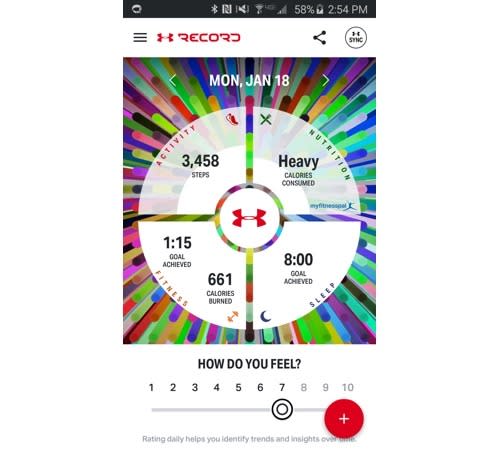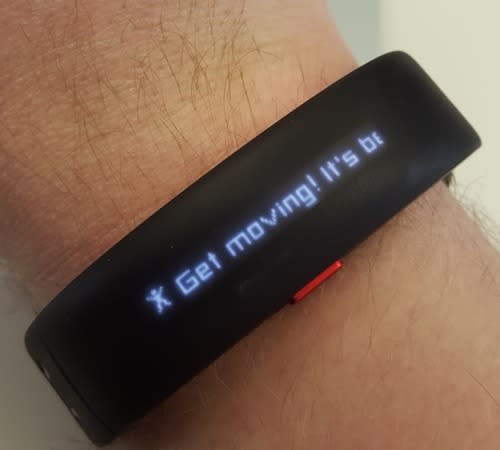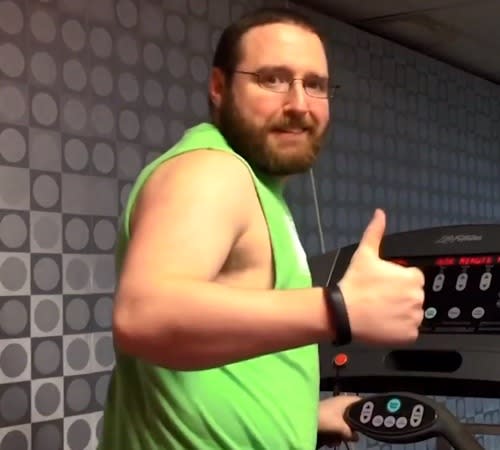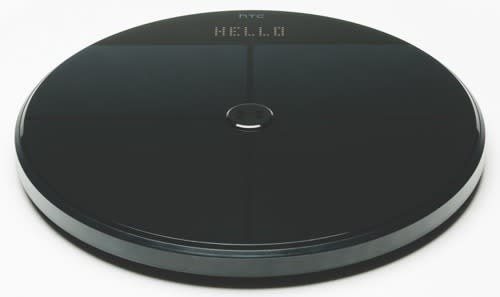Review: Can This All-in-One Fitness-Tracking System Really Get You in Shape?
Just as many of us are beginning to flake out on our New Year’s resolutions to lose weight and get more exercise, HTC and Under Armour have released a new all-in-one fitness tracking system called the UA HealthBox.
The $400 package includes a UA Band fitness tracker, a UA Scale digital scale, and the UA Heart Rate monitor. At the same time (but separately), Under Armor also debuted a new $150 connected running shoe called the Speedform Gemini 2.
All of the HealthBox components and the Gemini 2 sneakers feed into Under Armour’s Record smartphone app, which collects data such as your weight, the number of calories you’ve burned that day, the number of steps you’ve taken throughout the day, and the hours you slept at night.
Can $550 worth of tech gear help me maintain my Adonis-like physique and fastidious eating habits? I spent a week giving the whole setup a try.

(Photo: Under Armour/ HTC)
One caveat before I tell you how that went: The Record app is supposed to work in conjunction with the company’s existing MyFitnessPal app, which lets you record everything you eat; it then calculates your caloric intake and tells you approximately how many calories you’ve burned. Unfortunately, that feature wasn’t enabled in time for my review. Instead, I logged what I ate every day in MyFitnessPal — an incredibly tedious task. In the Record app, I used the Light/Medium/Heavy presets to give it an approximate sense of how much I consumed.
Day 1: Getting started
Today I ate a relatively normal amount of food — below MyFitnessPal’s suggested 1,700 calorie level — and spent a solid two hours at the gym. The result, according to app at least, was a deficit of a few hundred calories by the time I hit the sack. In theory, the more calories I expend compared to those I consume, the more weight I should lose. We shall see.

(Photo: Daniel Howley)
After the gym, I synced the UA Scale with my smartphone and weighed myself. At 195 pounds, I’m on the “bulky” side for my height. (I prefer to think of myself as substantial.) The scale automatically sends your most recent weight to the UA Record app, so you can track how much you’ve lost or gained over time.
Unfortunately, like most members of my family, I have a penchant for late-night snacking. And by that I mean I can demolish a jar of peanut butter at 3 a.m. without breaking a sweat.

On this particular night, I woke up and — in my disoriented, sleep-drunk state — ate three spoonfuls of Jif, then immediately went back to bed.
Day 2: Gym, tan, midnight snacking
I woke up this morning and remembered to enter the peanut butter I ate last night in MyFitnessPal. I added it to yesterday’s list of food, so I could feel like I was getting a fresh start to the day. Despite my nocturnal noshing, I was still under yesterday’s caloric allotment. Yay me!
After work, I hit the gym and spent time lifting weights. Unfortunately, as with most fitness trackers, Under Armour’s UA Band can’t how much you’re lifting or how many reps you’ve performed. Instead, it tracks the time you spend lifting and spits out a guess of how many calories you burned, based on your heart rate throughout the workout.

(Photo: Calen Cooper)
One hour and 12 minutes of me getting ripped, according to the band, burned 627 calories.
The UA Band is relatively comfortable to wear. Sure, there were times when I couldn’t help noticing it on my wrist, but that was usually because I’d set the band too loosely.
The Band uses a touch-screen interface that allows you to scroll through settings and features, including its heart-rate monitor and digital alarm. You can also do things like manually select the kind of workout you’re doing, see how many steps you’ve walked, and manually start the band’s sleep tracker.

Speaking of which, it turns out I hate wearing anything on my wrist when I go to bed. Fortunately, the UA app lets you manually record how long you slept, though doing this eliminates the opportunity to see how much you move at night.
Oh, and I woke up at 3 a.m. again and ate four tablespoons of peanut butter.
Day 3: Running man
Another day, another morning of telling MyFitnessPal what I ate in the middle of the night. As it turns out, overall I’m eating way too much fat. Who knew?
While at work later in the day, just after I logged my breakfast into MyFitnessPal, the UA Band notified me that I had been idle for more than 60 minutes, and suggested I move around.
In theory, this kind of feature is fantastic. Why wouldn’t I want reminders to be active? In practice, though, it’s pretty annoying. There are times during my work day when I simply can’t get up from my desk. Fortunately, Under Armour lets you turn this feature off entirely.

(Photo: Daniel Howley)
Once again, I hit the gym after work, lifted weights, and ran a few miles. This time I slipped on Under Armour’s SpeedForm Gemini 2 connected sneakers and strapped the UA Heart Rate monitor to my chest.
On the positive side, these shoes are seriously comfortable. But, on the other hand, they also require you to use yet another app, Under Armour’s MapMyRun. That’s three different apps I’m now using to keep track of my fitness. (At the very least, my thumbs should be getting a good workout.)
The MapMyRun app provides you with the distance and duration of your run, while also calculating your pace and the number of calories you burned. You can also see how many more miles you have left on your shoes before you need to buy a new pair.
Naturally, each of the Under Armour apps includes a social feature that lets you share your workout information with friends. I’m pretty certain my friends couldn’t care less about my daily workouts, so I avoided using it. Besides, I already have enough social media apps I can use to brag about how awesome I am.

(Photo: Daniel Howley)
The UA Heart Rate monitor is more accurate at tracking your heart rate than the UA Band. That’s because it makes contact with your chest at two points, allowing it to better capture your ticker’s beats. I found it relatively easy to put on and hide under my shirt. But it’s not the most comfortable thing to wear around your chest, because you have to strap it on pretty tight to make sure it doesn’t fall off.
The monitor also has a small puck in the center of the strap to hold its electronics. Under Armour decided to embed an indicator light in the front of the puck that tells you how hard your heart is working. It’s an interesting concept, but it really just ends up making you look like a cut-rate Iron Man.
Day 4: Burning up
I like working out as much as the next person, but I like eating junk food and drinking Scotch a hell of a lot more. And that’s pretty much all I did today. In my defense, it is Saturday.
During my time with the UA Band and UA Record app, I’ve noticed that I seem to burn a lot of calories just walking around. Granted, I live in New York City and have to walk to get most places, but I’m regularly burning 1,700 or more calories simply walking around.

MyFitnessPal keeps reminding me how many grams of fat and how much sugar I can consume if I want to lose weight; unfortunately, I keep blowing past both limits.
Still, it’s incredibly helpful information. I’ve been trying to drop some pounds for a while, and could never understand why I didn’t, despite going to the gym regularly. As it turns out, I’ve been eating a ton of fat and sugar (and peanut butter).
Day 5: Same old, same old
Today is my last entry day, and I’m starting to see why people fall off the wagon when it comes to fitness tracking. Entering everything I eat into the MyFitnessPal app got real old real fast.
And while I appreciate the insights the app provides into my overall health, I’m not sure how long I’ll keep using it everyday. The tedium of it, combined with the discouraging conclusions, aren’t great motivators.

(Under Armour/ HTC)
The UA Record app and UA Band, on the other hand, are far more convenient because nearly everything you do with them is automated. And strapping on the SpeedForm 2 shoes isn’t a problem. I do wish, though, that the extra app required to keep track of your pace and steps was wrapped into UA Record.
The bottom line
I’m the kind of person who tries to stay relatively healthy. I go to the gym at least three times a week, and make a passing attempt to watch what I eat. But I still don’t think I could justify spending $400 on the entire UA HealthBox package and another $150 for the shoes.
Sure, having a scale that tracks my weight and sends it to my smartphone is nice, the UA Heart Rate monitor gives me a good idea of how well my engine is running, and the shoes are comfortable. But I never felt like the three of them made me want to work out more or eat better.
In truth, I got the most benefit out of the UA Band, UA Record app, and MyFitnessPal. Seeing how many calories I was eating and how many I burned motivated me to be more healthy. Fortunately, Under Armour will be selling each piece of the UA HealthBox separately.
That means you can buy the UA Band for $180. And while that’s on the pricey side for a fitness tracker, I think it’s worth it when you combine it with the data-collection tools of the UA Record and MyFitnessPal apps.
Now if I could just find a way to stop eating in the middle of the night.
Email Daniel at dhowley@yahoo-inc.com; follow him on Twitter at @DanielHowley or on Google+.

